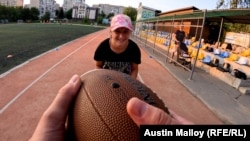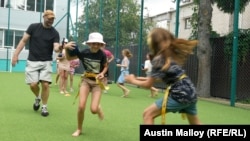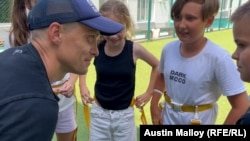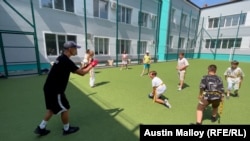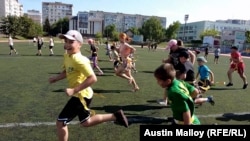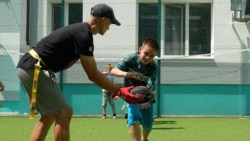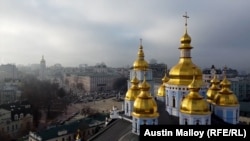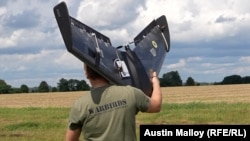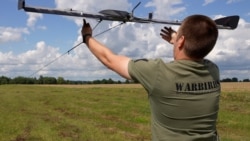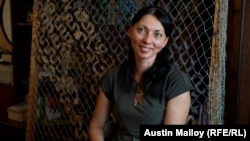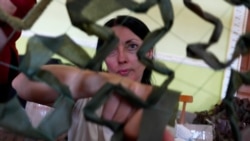KYIV -- I was playing flag football with a group of teenagers when the air-raid siren blasted. My instinct was to run, but the kids were walking. They’d experienced it many times before, but for me this was new.
I spent nearly four years living in Ukraine as a journalist before leaving in January 2022, just weeks before Russia launched its full-scale invasion.
Now, I was back.
Much had changed. When I was preparing to leave the country, Kyiv was filled with speculation: Would Russia attack or wouldn’t it? Now, here I was, with a war-weary 12-year-old named Polyna.
I had returned to Ukraine to report on three stories. The first was flag football.
Football For Freedom
When the International Olympic Committee recently added flag football to the 2028 Los Angeles games, they probably weren’t thinking about the impact that decision would have on the Vinnytsya Wolves, a small club team some 250 kilometers southwest of Kyiv.
For Wolves head coach Yevhen Khomyn, the chance to represent Ukraine at the Olympics has helped fuel his passion for developing the sport at the grassroots level. It’s a lucky break for the 36-year-old coach, who recently left his job in IT and then dedicated himself to promoting flag football in Ukraine. He tells me that’s been his “dream since childhood.”
He also tells me how difficult it was to watch his wife and two young sons leave for Romania during the first days of this war, not knowing when he’d see them again. And then there’s the volunteer weapons training he attends every week in case “it will be necessary to protect our city or our country,” he says.
With his days as a civilian possibly numbered, Khomyn is laser-focused on chasing his dream. It’s one reason why he reopened youth practices and started to recruit new players amid the hardships of Russia’s ongoing assault on the country. His practices not only show local boys and girls a new game, but also give them a chance to “be like champions,” says Khomyn.
As a former football player, I get Khomyn’s love of the game. But I have no idea what the pain of nearly losing everything must feel like. It’s a pain most every Ukrainian must feel, though few seem to ever talk about it.
While the Vinnytsya native hopes his youth practices of today could be laying the foundation for a future Olympic medal, he knows that football glory is not the priority in wartime Ukraine.
“[The kids] should have a place where they feel safe,” he says.
For the young players living through a constant threat of Russian aerial attacks, weekly trainings give them a chance to have a childhood.
“They think that they are alone in the world,” says Khomyn, “but when you’re part of the team, you’re feeling like you’re part of something bigger.”
He believes this is especially important for the dozen or so children from displaced families who joined the team earlier this year.
“Let’s throw the ball,” 12-year-old Polyna Bezkorovayna, a new Wolves player who fled her home in the Zaporizhzhya region as Russian forces invaded, says to me. It’s the third time she’s asked me today.
With her father at the front line and her mother working in Poland to make ends meet, Polyna now lives in Vinnytsya with her aunt. She’s surprisingly cheerful given the circumstances. All she wants to do is play.
Polyna teaches me how to put on the belt with flags before running pass routes she learned earlier in the day. She catches throw after throw with ease. She’s a natural.
We are about to run another play when air-raid sirens sound the alarm ahead of a Russian attack. Around 50 players and coaches head for shelter.
“I think the sirens will stop in 20 minutes, like always,” Polyna says as she clears the field. “I’ll be back when they finish,” she adds before heading to an empty apartment to wait out a possible Russian missile strike alone.
Fortunately, Vinnytsya was not hit. Twenty minutes later, the players and coaches return to practice. Polyna and I resume our game of catch. She seems unfazed by what’s become an almost daily routine.
It feels good to be around the team after facing one of my first air-raid sirens. It’s a chilling experience no one should have to go through.
I watch Khomyn teach his players a new drill on a sun-dried soccer field with worn-out footballs.
“We are not just players, we are family,” he told me before the air-defense warning.
With his sons now by his side at most practices, Khomyn’s real family, and his football family, are together again. The sport, it seems, is just one avenue for him to bring them closer during difficult times. And the lofty Olympic dream is just big enough to keep him going.
A Bird's-Eye View Of Kyiv
The last time I saw Kyiv was on January 15, 2022, a little over a month before Russia launched its full-scale invasion. Back then, when I was one of the few people in the city with a drone, the skies above the Ukrainian capital were my playground. Now, a war of drones dominates those same skies.
It’s hard to fathom. A tool I used to capture stunning footage of Kyiv’s golden-domed churches is now an increasingly vital weapon of war.
While Russia is using drones to launch daily attacks on Ukrainian cities, unmanned aerial vehicles (UAVs) armed with the latest technology are helping Kyiv punch above its weight on the battlefield.
Ukrainian UAV manufacturers have made technological leaps and bounds in the last year alone. Artificial intelligence and smart tech are now helping homegrown aircraft to fly despite Russian electronic jamming.
Dmytro Kovalchuk, co-founder of Warbirds Of Ukraine, says that his company is just one of many in Ukraine that is constantly upgrading its drone fleet with new tech.
“We are putting a lot of resources into research and development,” he says. “New technology,” Kovalchuk adds, “will help Ukraine defend itself against Russia.”
He’s happy to speak to the media but is understandably guarded when it comes to discussing details about Ukraine’s highly secretive domestic drone industry. The former drone reconnaissance pilot doesn’t hide the fact that innovation is a top priority as we tour an undisclosed production facility on the outskirts of Kyiv.
“We are in a competition with our enemy over who will make a smart drone first,” he says.
As a drone enthusiast, I marvel at the UAVs he shows me. They’re so much more capable than anything I’ve used that I wouldn’t know the first thing about flying them. I tell Kovalchuk about my drone, which I once flew for a record flight distance of 3 kilometers in perfect conditions.
He tells me one of Warbirds Of Ukraine’s latest models “can even fly to Moscow.”
Ukraine's Camo Queen
“This isn’t borscht,” she says as she lifts the lid on a big red pot that’s sitting on her stove. “This is where I color the material [green].”
With new capabilities in aerial reconnaissance, soldiers on the ground need better cover to avoid detection. Luckily for Ukraine, hundreds of volunteer groups across the country and abroad make homemade camouflage nets and ghillie suits for military personnel.
Many of the groups learned their craft from camouflage guru Olesia Koryahina. Her apartment is full of DIY camouflage earmarked for soldiers on the front line.
She lifts the lid on another pot to reveal a piping hot soup. The dedicated volunteer serves me a bowl as she explains how she helped build an international network of camouflage producers. She’s quick to give others credit.
“There are many groups I’ve helped set up, but they’ve done most of the work by themselves,” she says.
Koryahina’s training videos have taught thousands of people how to weave the protective mesh. She also handles logistics and communications for over 100 volunteer groups.
In the next room, Koryahina tries on a homemade mosquito head net that she says can be tailored to match Ukraine’s seasonal foliage. The low-cost camo is in high demand as Ukraine’s counteroffensive continues to grind forward.
When I ask what motivates her to give so much of her time and energy to help defend Ukraine, she answers, “I have a son, and I want him to live in a free country.”
Koryahina’s volunteer efforts provide some small relief to a country struggling with depleting resources. But it will take much more than camouflage netting to give Kyiv the support it needs, especially as the country braces for what promises to be a harsh winter.
At the end of the trip, there's a sense of relief as I cross the border into Poland and the security of the European Union.
I share a train sleeper car with a Ukrainian mother and her two young sons. She tells me they’re happy to have a break from the war as her boys climb into bed.
I’m just about to doze off when the air-alert app on my phone warns me of an incoming strike on Vinnytsya. I shut it off before it wakes the family now sleeping silently in the dark and rumbly train.
I'm kept awake by thoughts of Polyna and others taking shelter in Vinnytsya as Russia launches yet another attack.




